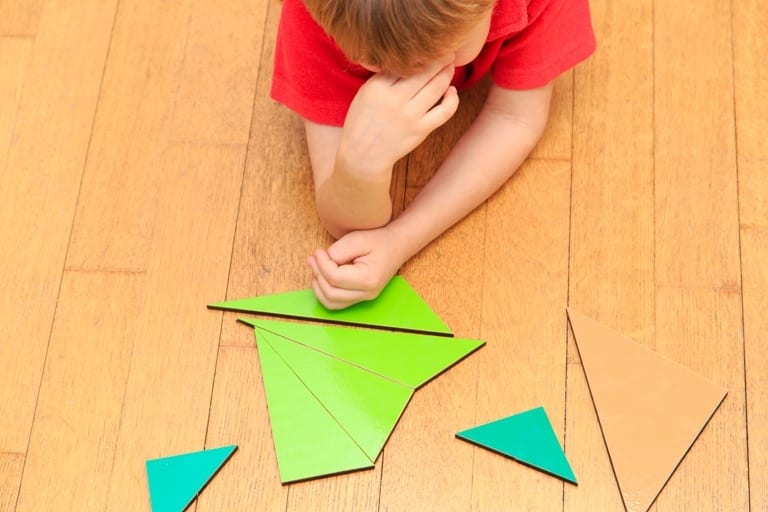Nonverbal Learning Disorder (NLD) or (NVLD), also called Nonverbal Learning Disability, is a brain-based developmental difficulty with nonverbal skills. The term that describes this deficit is confusing, because one might think NLD describes a child who is “nonverbal” and therefore has trouble with words. Actually, children with NLD are exceptionally verbal, in fact, more verbal than most.
Kids with nonverbal learning disorder are often bright enough to be considered gifted, especially in the early years. At a young age, their amazing vocabularies easily outstrip those of their peers and they memorize and rattle off facts in a flash. They learn to read early, too.
The problems that come with nonverbal learning disorder may begin in preschool. Kids with NLD have trouble interacting with the other kids. They have trouble mastering basic self-help skills (like getting dressed on their own). They’re clumsy, always bumping into things, spilling their drinks, and always missing the ball in a game of catch. In general, they just can’t seem to adapt or fit in. They don’t make friends. They don’t seem to get the point of pictures or puzzles. At this point, the parents, who always thought their child exceptionally smart (and they are right!), begin to understand that something is wrong, though the alarm bells aren’t yet going off.

More or less, these children muddle along, somehow pulling through third grade with only a few hiccups. They do okay in class, except for anything having to do with their fine motor skills, for instance hand writing/penmanship. Math can be a problem. Symbols for addition and subtraction may be missed by children with nonverbal learning disorder—it’s as if they just don’t see them. Still, they pass first grade into second grade and on into third grade.
It’s in the fourth grade that things really begin to fall apart. In the first three grades, children are learning to read. After that, kids are reading to learn. They’re also expected to be somewhat independent in the way they handle learning tasks.
But kids with nonverbal learning disorder can pick up on names of places and dates in their reading and still miss the main idea of the story. Kids with NLD get lost on their way to school or from classroom to classroom. They forget to do their homework. They’re often unprepared for class; find it very hard to follow instructions; have a terrible time with math; can’t deal with understanding how to color in the countries on maps; can’t write stories or compose essays; often misunderstand their teachers and classmates; and as a result of all this, are filled with anxiety outside the home and angry inside the home (is it any wonder?).

Because their verbal skills are so good, and because they are so obviously bright, teachers may make judgments about children with NLD, and decide they are refusing to cooperate, or that they are lazy, or maybe rude. And of course, none of this is true. As a matter of fact, children with NLD tend to be focused on the goal, honest to a fault, and hardworking, too. They’re not lazy or uncooperative and they’re not impolite: they have NLD.
Nonverbal Learning Disorder Is Controversial
NLD is not mentioned in the latest issue of the Diagnostic and Statistical Manual of Mental Disorders, the DSM V. NLD is also not listed as a disability under the Individuals with Disabilities Education Act (IDEA), though children with NLD may still be eligible to receive special education services. Experts have found that there is less activity in the right cerebral hemisphere of the brain in children thought to have NLD. Until today, NLD remains a controversial diagnosis, but when the symptoms fit your child, you know it’s real.
Because NLD fails to receive official recognition as a disability or disorder, it’s not as well known as other disabilities related to language, for instance, dyslexia.
Signs of Nonverbal Learning Disorder
Some signs of NLD:
- Excellent recall—they remember everything they hear
- Poor visual memory—they don’t remember the things they see
- Good at reading
- Very poor math skills
- Excellent verbal expression and reasoning skills
- Difficulties with written expression
- Poor handwriting
- Spatial awareness difficulties, for instance problems with estimating size, shape, distance, and poor sense of direction
- Inability to correctly read facial expressions or hand gestures, tones of voice, and social cues
Because the focus on learning in the early elementary school years is on reading, NLD can easily—and often does—go unnoticed and undiagnosed. Reading ability is the sole indication used by educators to gauge academic success. And since NLD children read well, no one pays much attention to their other, very real difficulties.
Main Characteristics of Nonverbal Learning Disorder
Here are the main characteristics of NLD:
- Sense of touch/feeling is distorted, especially on the left side of the body
- Poor coordination, especially as it relates to the left side of the body
- Visual-spatial planning difficulties (may misjudge the distance to an object he sees and as a result, may collide with that object)
- Pronounced difficulty in adapting to new or complex situations
- Falls back on learned rote behaviors (sometimes inappropriate) in new situations
- Cannot interpret social cues, has poor social judgment, fumbles social interactions
- Poor perception of time
- Large vocabulary
- Counts on language for building relationships, for gathering information, and for relieving anxiety
- Poor arithmetic skills, poor understanding of scientific principles and theories
- Early childhood attention and hyperactivity issues (often confused with ADHD) followed by later social withdrawal and isolation
- Intelligence tests will show high verbal IQ and poor performance IQ due to visual-spatial difficulties
Children with nonverbal learning disorder may seem like miniature adults because of their advanced verbal skills. They understand the world with words and lots of them. They often learn to read before the first grade. They are always asking questions of the adults they know rather than going out into the world and finding the answers for themselves.

With words, they feel comfortable. But the visual perception difficulties and physical clumsiness of children with nonverbal learning disorder make it hard for them to understand the physical world. By asking questions instead finding opportunities to learn through experience and exploration, the awkwardness of nonverbal learning disorder is only made worse, through lack of trying.
In high school and on into college, learning in the classroom turns into a nightmare for the person with NLD who struggles to understand the meaning of a lecture (information that is heard), while struggling with the motor problems of taking notes (slow, difficult, clumsy handwriting). People with nonverbal learning disorders also cannot distinguish between important and unimportant details and information. The student with NLD may know all the names of the battles fought during the Civil War, but may fail to understand the reason for the war (the issue of slavery).
Social/Emotional Issues with Nonverbal Learning Disorder
And then there are the social emotional issues. It is thought that there is some overlap between Asperger’s syndrome and nonverbal learning disorder. People with NLD don’t understand nuance of tone, for instance sarcasm. They understand words in a literal way only. If you say to your child with NLD, “Why don’t you just throw all the clothes I just washed, dried, and folded neatly onto the floor instead of putting them away carefully in your bureau drawer,” you might see your child literally throw those freshly laundered clothes on the floor.
He meant well.
Supporting Those With Nonverbal Learning Disorder in the Classroom
Teachers can help students with nonverbal learning disorder by creating PowerPoint presentations with headings to accompany their lectures, to offer nonverbal context to the material. Having a chart with the day’s academic schedule is also a good thing—it offers a reference to help the student with NLD organize himself and his classroom materials. Keeping to a routine is also very helpful. Tasks should be broken down into the smallest possible pieces in a logical sequence. Classroom time is better spent in discussion than in lectures, as this helps the student with NLD learn how to pull out concepts and the important details from the information he hears and reads.
NLD and Learning Social Skills
Last but not least, children with nonverbal learning disorder need help to learn how to be effective in social situations. One way to do

this is to play games in which children must guess the emotions that go together with the facial expressions you show them (angry, confused, happy, sad) or the tones of voice you use (sarcastic, tense, impatient). The next level is to have them guess the appropriate social responses to expressions, gestures, and tones of voice.
It is very helpful to people with nonverbal learning disorder to have those around them explain the expressions, gestures, and tones they use as they use them in everyday interactions. “This is me being sarcastic.”
It’s not an easy road to travel, having NLD or parenting a child with NLD, but with patience and effort, you will see improvement.
What are some of your favorite tips for supporting the child or adult with NLD?

MS. Epstein- I was diagnosed with a cognitive disorder, NOS, because NLD is not in the DSM or other ‘official’ disabilities lists. I was in my fifties when this diagnosis occurred, and now, all the failures I’ve encountered make sense. Your NLD article is in fact, my biography. How can we, or suppose I, get the so-called experts who write the DSM to recognize NLD as the destroyer of hopes, dreams, and livelihoods that it is?
David, that was tragic to read. 🙁
You ask an excellent question, but I would caution that it may not be such a wonderful thing for NLD to be listed in the DSM. ADHD is listed there, which means it is considered a mental health issue, rather than a physical health issue. Is that really how we want to look at NLD? Is that accurate? Do we want to classify all learning difficulties as mental illnesses?
From my perspective, there are no practical resources or help for an adult with NLD. I have this, this disability, because that is what NLD is, a disability. After being diagnosed I was told “good luck!”. I’ve sought counseling, and who provides counseling? Mental health practitioners. But do they know anything about NLD? As your article states, by the fourth grade things come apart. I had a nervous breakdown in the fourth grade. I ran away from home and from school because I read and comprehended on a high school level but I could not figure out long division, fractions or percentages. I had dyscalculia but no dyslexia. So my grammar teacher though I had to be cheating somehow and my math teacher thought I was just lazy if not stupid and my father thought the same thing, that I just didn’t want to apply myself. This dichotomy has not gone away, and it is a mental issue. I have needed help with this, and because NLD is not recognized there are no resources, no real practical help at all. So, yes, from my perspective NLD is a mental health issue.
I hear. You make a very good case for calling NVLD a mental health issue.
Join this organization: https://nvld.org/
Tell your story on the website. Take part in studies.
Lobby the APA to list NVLD in the DSM and lobby Washington to do something important to help people like you who are suffering so much!
Please update me from time to time and let me know if you are making progress. I would love to help you any way I can, perhaps by writing about your experience for our readership.
Feel free to use my story. NLD is very real, very destructive and apparently disregarded by the so-called experts. This needs to change.